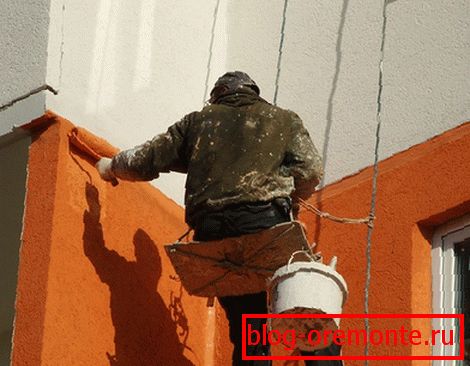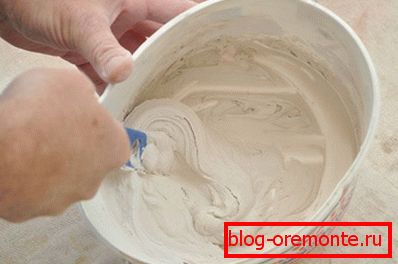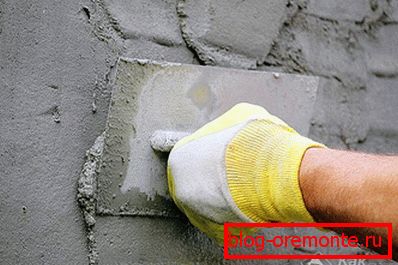How to apply bark beetle plaster
The new century gives rise to many technologies. Today, for the finishing of facades and walls of buildings, bark beetle plaster is successfully used. With her appearance she made a real breakthrough in the design of the facade of buildings. In this article we will describe how to apply decorative bark beetle plaster, as well as give video and photo instructions.
What is different
This decorative plaster is a granular white powder. The granules contained in it can be of different sizes. It is thanks to these stones that everyone's favorite effect is achieved - imitation of damage to the surface by insects - this gives the coating individuality. It is for this feature that the plaster got its name.
Due to the large variety of granule size, a completely unique coating pattern can be obtained.
Note! The most common is the average size of stones - 2.5 mm. In this case, a pronounced pattern with a beautiful pattern will appear on the surface.
Composition

The mixture is based on mineral filler. It is he who plays the role of a link.
The main components of the plaster also include the following components:
- marble chips,
- acrylic copolymer
- titanium dioxide,
- cement.

Standard production involves the production of a white mixture. To change its color, it is necessary to conduct additional tinting. To do this, add special paints to the finished mixture. You can also paint the finished and dried surface.
Basic properties
Speaking of bark beetle plaster, it is necessary to note its main distinguishing features:
- the mixture is resistant to various atmospheric manifestations,
- has a high level of strength
- resistant to sudden temperature changes
- has moisture resistance
- safe for the environment
- does not collapse under the influence of ultraviolet radiation,
- does not fade in direct sunlight
- resistant to various chemical agents
- damage resistant
- not subject to burning
- durable
Selection of surface for work

The bark beetle plaster may not be used on all types of surfaces. So, it is not designed to work on horizontal grounds.
- In some cases, it can be used to finish the ceiling.
- Well lays on plastered surfaces.
- Suitable for working on oiled walls.
- It can be applied on previously prepared following types of surfaces:
- tree,
- brick,
- concrete,
- a rock,
- plasterboard,
- DSP.
Type of plaster

The modern construction market is represented by various modifications and types of decorative plaster. To determine which of the presented mixtures is most suitable, the following recommendations should be taken into account:
- Mixtures are available with different composition and type of grit. Before you start, you should choose what type of grain is needed to obtain a picture.
- It is worth remembering that when choosing a plaster with a high level of grit (for example, 3.5 mm), the material consumption during work will be increased. Therefore, in this case it will be necessary to purchase a larger amount of material.
- There are 2 main types of plaster:
- the mixture is ready to use,
- dry material.
Dry material must be further prepared for use. When purchasing a ready mix, no additional actions are required. However, this type of material has a higher cost compared to dry.
Cooking

Consider how to properly prepare the mixture for work:
- Prepare a container for preparing the mixture. This may be a regular basin or bucket.
- Pour into a container of warm water with a temperature of up to 20 degrees.
- Based on the recommendations on the packaging of plaster, gradually begin to fall asleep dry mixture in water.
- Watch for lump formation. To prevent this, it is necessary to constantly stir the mixture.
- When the mixture is homogeneous, it must be left for 15 minutes to set. Capacity should always be covered with a lid.
- Mix well the resulting solution.
When preparing the material, it is necessary to consider the following nuances:
- The shelf life of the finished mixture is not more than 3 hours, it must be used immediately after production.
- The finished composition must not be diluted with water or add to it a dry mixture. This contributes to the destruction of the material and the loss of its basic properties.
- It is necessary to constantly monitor the finished mixture and prevent it from freezing in the process. To do this, it must be periodically mixed.
Surface preparation

Before starting the application of plaster surface must be prepared for work.
- Cleaning up It is necessary to remove dust and dirt from the surface. To prevent the spread of germs, it is recommended to apply an antifungal mixture to the wall.
- Alignment Plaster is applied only on a flat surface.
- After drying, it is necessary to close all the cracks and chips with putty.
- Padding. A layer of primer must be applied when working with bark beetle plaster. If you choose a thick primer mixture, it is enough to put it in a single layer. If the primer is a liquid consistency, it should be applied to the wall in several layers. To prevent dark spots on the walls, choose a primer mixture of light shades.
- Drying the surface. Only after complete drying of the walls can you go directly to work with plaster.
Application process

Consider the main nuances of the work. For the application of the material we need the following materials:
- Putty knife.
- Plastic grater. It is necessary to create unusual patterns on the surface.
- Capacity with warm water.
- Soft fabric

Work process:
- Application should start at the bottom right corner of the wall. A small amount of the mixture is applied with a spatula to the wall and evenly distributed over it.
- Try to prevent the formation of voids and gaps.
- After the base coat has been applied, it must be smoothed with a trowel. This will align the mixture.
- To prevent scratches on the surface and sticking of the mixture to the spatula, it must be periodically moistened with warm water and wiped with a cloth.
- After coating, it is necessary to withstand 30 minutes, if the surface does not shine when viewed from a side view, you can proceed to further work.
- Creating a pattern. It is necessary to press the construction grater to the surface and hold it along the wall. If you need a horizontal pattern - the movements of the grater should be directed horizontally. With vertical tool movements, a vertical pattern will be obtained. If you need a circular pattern, the movements should be chaotic. If you combine vertical and horizontal movements, you can achieve a cross-shaped pattern.
- After completing the work, the surface should be allowed to dry for half an hour, then re-run on the entire wall with a float. The tool must be clean.
- The finished surface dries within two days. After that, you can proceed to staining. Paint is applied with a roller in 2-3 layers.
A photo
The main examples of coatings treated with bark beetle are shown in the photo:





Video
For more information on the process of applying bark beetle plaster can be found in the following video: